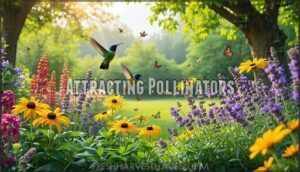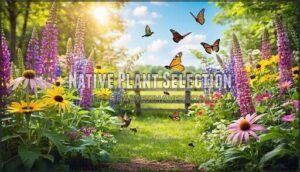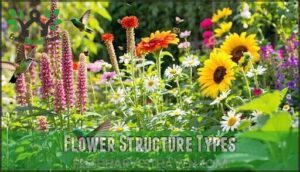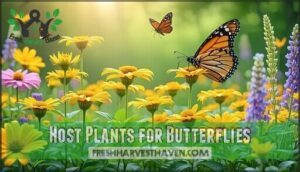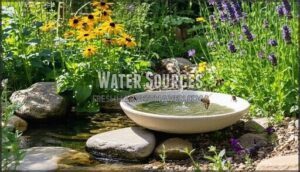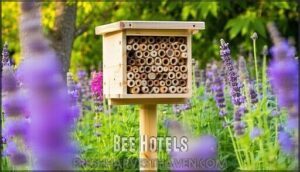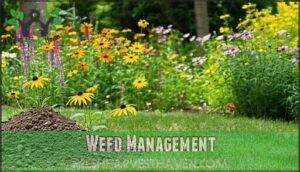This site is supported by our readers. We may earn a commission, at no cost to you, if you purchase through links.
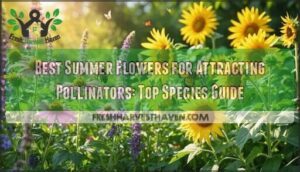
These native beauties provide the nectar and pollen that bees, butterflies, and hummingbirds crave during peak summer months.
Sunflowers and zinnias also work like magnets for beneficial insects, while lavender keeps blooming through late summer heat.
Choose flowers with different bloom times and shapes to feed various pollinator species throughout the season.
Native plants require less water and maintenance while supporting local wildlife better than exotic varieties.
Your garden becomes a bustling ecosystem when you select the right combination of these pollinator-friendly plants.
Table Of Contents
- Key Takeaways
- Pollinator Importance
- Attracting Pollinators
- Summer Flowers Selection
- Creating Pollinator Gardens
- Maintaining Pollinator Gardens
- Frequently Asked Questions (FAQs)
- What are the best summer flowers for pollinators?
- What is the summer flower for bees?
- What flowers attract bees the most?
- What is a good flower that blooms all summer?
- What summer flowers are good for pollinators?
- What flowers are best for a pollinator garden?
- What is the best plant to attract pollinators?
- Which flower attracts the most pollinators?
- What flowers bloom best in summer?
- What is a bee hummingbird’s favorite flower?
- Conclusion
Key Takeaways
- You’ll maximize pollinator visits by choosing native plants like bee balm, black-eyed Susan, and purple coneflower that require less water while providing superior nutrition for local species.
- You’ll support different pollinators by selecting varied flower structures—tubular blooms for hummingbirds, open-faced flowers for bees, and flat platforms for butterflies.
- You’ll create a complete ecosystem by including both nectar sources and host plants like milkweed for monarch butterflies, supporting the full lifecycle of beneficial insects.
- You’ll maintain continuous blooms by deadheading spent flowers and choosing varieties with different bloom times, ensuring food sources throughout the entire summer season.
Pollinator Importance
You’ll discover that pollinators are responsible for producing one-third of the food we eat, making them essential partners in our daily meals.
Without pollinators buzzing through our gardens, grocery shelves would look dramatically empty and food prices would skyrocket.
These busy creatures also pump approximately $29 billion into U.S. farm income annually while maintaining the delicate balance of ecosystems that keep our planet thriving.
Role in Food Supply
Everyone benefits when pollinators do their job right.
These tiny workers contribute to producing one-third of our global food supply through crop pollination.
Without their ecosystem services, you’d face serious food security challenges.
Pollinator conservation directly impacts agricultural productivity and your dinner table.
- Crop Production: 75% of flowering food crops depend on animal pollinators
- Food Security: Pollinators guarantee diverse, nutritious harvests year-round
- Agricultural Impact: $29 billion annual contribution to U.S. farm income alone
- Summer Blooming Flowers: Pollinator-friendly flowers support this important relationship
Economic Impact
How much do pollinators boost your wallet? They contribute approximately $29 billion annually to U.S. farm income through crop pollination of 58 essential food crops.
This economic impact reduces pollination costs while driving market growth and food security.
Tourism flourishes as pollinator-friendly plants create garden attractions.
Growing pollinator-friendly herbs supports pollinator conservation and ecological value.
Environmental Benefits
Beyond economic gains, pollinator-friendly flowers create ecological balance that transforms your garden into an environmental powerhouse.
These summer pollinator plants boost biodiversity while supporting carbon sequestration—nature’s way of cleaning our air.
Attracting bees flowers and native pollinator plants strengthen ecosystem health through habitat preservation.
Your pollinator garden ideas reduce pesticide dependence, creating thriving spaces where beneficial insects flourish.
It’s like giving Mother Nature a helping hand while building a vibrant sanctuary that supports countless species beyond just the pollinators themselves.
By understanding the importance of pollen transfer methods, gardeners can make informed decisions to enhance their garden’s ecological impact.
Attracting Pollinators
You’ll discover that selecting the right flowers can transform your garden into a bustling pollinator paradise, with each bloom serving as a specialized landing pad for different species.
The key lies in understanding what attracts hummingbirds, bees, and butterflies, then choosing plants that cater to their unique feeding preferences and behaviors.
Hummingbird Attractions
Hummingbirds transform gardens into vibrant ecosystems when you plant the right nectar sources.
These feathered friends prefer tubular flowers with deep throats that match their specialized beaks perfectly.
Here are five top summer pollinator plants for attracting hummingbirds:
- Salvia – Purple and red blooms provide consistent nectar through summer
- Cardinal flower – Brilliant red tubular flowers bloom midsummer
- Trumpet vine – High nectar output with continuous summer feeders
- Bee balm – Scarlet blooms act like dinner bells for pollinatorfriendly flowers
- Coral honeysuckle – Native vine with orange-red blooms
Red blooms work best since hummingbirds see this color exceptionally well.
Plant these attracting hummingbirds flowers in clusters for maximum impact.
Bee Attractions
For attracting bees to your summer garden, focus on bee friendly flowers in blue, purple, and yellow hues.
These best flowers bees adore include lavender, sunflowers, and coneflowers – all excellent pollen sources and nectar plants.
Plant bee garden plants with open faces like zinnias for easy access.
Add bee hotels nearby for nesting spots.
Floral scents from herbs like basil and oregano create irresistible pollinatorfriendly flowers that’ll keep bees buzzing happily all season long.
Choosing the right bee friendly flowers is essential for creating a thriving pollinator garden.
Butterfly Attractions
Creating butterfly-friendly pollinator gardens starts with understanding what draws these winged visitors.
Butterflies need specific flower colors, garden layouts, and butterfly bush varieties to thrive.
Here’s your butterfly attraction blueprint:
- Plant butterfly garden plants like zinnias and cosmos for continuous nectar sources
- Design strategic garden layouts with sunny spots and wind protection for delicate wings
- Add butterfly feeders near pollinator-friendly plants to supplement natural food sources
Choose flowers for pollinators with flat landing platforms and bright colors.
Attracting butterflies plants work best when clustered together, creating visual beacons that say "buffet’s open!
Incorporating native plant species can substantially enhance the attractiveness of your garden to pollinators.
Summer Flowers Selection
Choosing the right summer flowers transforms your garden into a pollinator paradise that buzzes with life all season long.
You’ll want to focus on native plants, diverse flower structures, and specific host plants that support the complete lifecycle of butterflies and other beneficial insects, creating a complete lifecycle of support.
Native Plant Selection
Native flowers work like a key fitting perfectly into a lock—they’re already adapted to your local pollinators’ needs. When you choose native species over exotic varieties, you’re supporting butterflyfriendly ecosystems that evolved together over thousands of years.
| Native Flowers | Best For | Bloom Time |
|---|---|---|
| Purple Coneflower | Bees, Butterflies | Mid-Late Summer |
| Wild Bergamot | Native Bees | July-August |
| Black-eyed Susan | Solitary Bees | Extended Summer |
| Cardinal Flower | Hummingbirds | Summer Migration |
| Swamp Milkweed | Monarch Host Plants | Peak Summer |
Local species offer superior nutrition—their pollen contains 18-20% higher protein than non-natives. This wildflower mix approach creates plant diversity that supports 90% of native bee species while requiring less water and care than exotic alternatives.
Understanding soil quality factors is essential for the health and growth of these native flowers.
Flower Structure Types
Choosing flowers by structure guarantees you’re rolling out the red carpet for different pollinator guests.
Tubular flowers like bee balm perfectly match hummingbird beaks, while daisy shapes such as sunflowers offer easy pollen buffets for bees.
Coneflowers provide sturdy landing pads for butterflies seeking nectar.
Color schemes and fragrant blooms with varied petal textures complete the pollinator paradise.
Look for these winning structures:
- Tubular flowers – Perfect nectar tubes for hummingbirds and long-tongued bees
- Daisy shapes – Open buffets where sunflowers and zinnias serve multiple diners
- Cone-centered blooms – Sturdy platforms where butterflies can perch and feed
- Fragrant blooms – Aromatic beacons that guide pollinators from miles away
Host Plants for Butterflies
Butterfly gardens need more than nectar sources—they require host plants where butterflies lay eggs.
Monarch butterflies depend exclusively on milkweed species, while black swallowtails choose parsley, dill, and fennel.
Milkweed benefits extend beyond monarchs, supporting 450+ insect species.
You’ll create a complete pollinator habitat by including both nectar flowers and these specialized host plants in your garden design.
Creating Pollinator Gardens
Creating a pollinator-friendly garden requires more than just planting flowers—you’ll need to provide essential habitat features that support pollinators throughout their lifecycles.
Beyond blooms, consider adding shallow water sources like bird baths or small dishes, installing bee hotels made from bamboo tubes or drilled wood blocks for solitary bees.
Managing weeds naturally to avoid harmful chemicals that can devastate pollinator populations is also crucial, as it helps maintain a safe environment for these beneficial insects.
Providing the right environment, including essential habitat features, is key to creating a thriving ecosystem for pollinators.
Water Sources
Water-source setup transforms your pollinator garden into a thriving ecosystem.
Pollinators need reliable hydration stations to fuel their busy schedules visiting your summer flowers. Simple pond creation or birdbath maintenance keeps these essential visitors happy and healthy.
Essential water features for pollinator gardens:
- Shallow dishes with landing stones for safe bee access
- Rain barrels that provide consistent water while conserving resources
- Drip irrigation systems creating gentle water movement butterflies love
- Small ponds with gradual edges supporting diverse pollinator-friendly plants
Change water regularly to prevent mosquito breeding and maintain crystal-clear quality.
Bee Hotels
Beyond providing water, bee hotels offer essential nesting boxes for solitary bees who don’t live in hives.
These insect houses support urban bees and boost bee conservation efforts in your pollinator gardens.
Your bee habitat needs:
- Natural materials like bamboo or untreated wood with 6-10mm holes
- Southeast-facing placement about 4-5 feet high
- Nearby pollinator-friendly plants and summer flowers
- Annual cleaning to prevent parasites and disease
Position your hotel near lavender or bee balm for instant pollinator appeal. Creating a bee hotel kit is essential for attracting solitary bees.
Weed Management
After setting up bee hotels, you’ll need proper weed management to keep your pollinator garden thriving. Invasive species can quickly overtake native plants, disrupting soil health and ecosystem balance.
Pull weeds by hand when soil’s moist—it’s like removing unwanted dinner guests before they eat everything. Mulch around drought-tolerant pollinators to suppress growth naturally.
Effective weed killer spray control methods are essential for maintaining a healthy garden ecosystem that uses weed killer products.
Choose low-maintenance, pollinator-friendly plants that naturally compete with weeds through strong root systems, ensuring a healthy garden ecosystem with effective weed control.
Maintaining Pollinator Gardens
You’ll keep pollinators coming back all summer when you deadhead faded flowers, prune overgrown stems, and give each plant enough space to grow.
It’s a bit like hosting a garden party—everyone needs room to mingle, and you want the snacks fresh and plentiful, which can be achieved by following these simple steps to create an inviting environment for your pollinators.
Deadheading Plants
Your deadheading game can make or break your pollinator-friendly garden this season.
Your pollinator garden’s success hinges on smart plant choices and consistent care.
Snip spent blooms just above healthy leaves using clean deadheading tools to redirect energy into fresh flowers.
This simple plant maintenance trick keeps summer flowers blooming longer, attracts more pollinators, and prevents disease.
Smart pruning techniques and consistent flower care turn good gardens into pollinator magnets through proper gardening tips.
Understanding why deadheading flowers is essential for a thriving garden.
Plant Pruning
After your flower trimming sessions, proper pruning tools and cut timing make all the difference in your pollinator-friendly garden.
Sharp, clean tools prevent disease while strategic stem care during the flowering season encourages robust blooms. Think of pruning as giving your plants a haircut—done right, they’ll thank you with more flowers!
Here’s your maintenance game plan:
- Leaf management: Remove yellowing or damaged foliage to redirect energy toward blooms
- Flower trimming: Cut back spent clusters to encourage second flushes
- Stem care: Trim one-third of woody stems on shrubs like butterfly bush for vigorous growth
Space Provision
Smart garden layout starts with understanding your pollinators’ needs.
Give bees and butterflies room to navigate between flowering plants by spacing them appropriately.
Vertical gardening works well in small spaces, creating layers of pollinator magnets.
Even urban planning can incorporate pollinator-friendly zones.
Your thoughtful yard design and space provision creates thriving habitats where beneficial insects feel at home during garden maintenance seasons.
Frequently Asked Questions (FAQs)
What are the best summer flowers for pollinators?
You can’t go wrong with these summer superstars!
Zinnias, sunflowers, and bee balm create a pollinator paradise.
Their vibrant blooms provide abundant nectar and pollen for bees, butterflies, and hummingbirds throughout the season.
What is the summer flower for bees?
You’ll love lavender for attracting bees with its aromatic purple blooms that act like nature’s dinner bell. Sunflowers and bee balm also work wonderfully, providing abundant nectar throughout summer months.
What flowers attract bees the most?
Like honeyed lighthouses in your garden, these blooms act as irresistible beacons for busy bees.
You’ll find lavender, sunflowers, bee balm, borage, and salvia top the list, offering rich nectar and vibrant colors that make bees buzz with excitement.
What is a good flower that blooms all summer?
You’ll love zinnias for their non-stop blooming power from late spring through first frost. These colorful champions produce endless flowers while feeding butterflies and bumblebees all season long.
What summer flowers are good for pollinators?
Zinnias, sunflowers, and cosmos bloom continuously, feeding butterflies and bees all season. You’ll love bee balm for hummingbirds, while lavender’s fragrant purple spikes attract countless beneficial insects to your garden.
What flowers are best for a pollinator garden?
Your pollinator garden blooms like nature’s candy store when you choose the right flowers.
Plant zinnias, sunflowers, and cosmos for butterflies, while lavender and bee balm draw bees with their nectar-rich blooms perfectly.
What is the best plant to attract pollinators?
You’ll find milkweed stands out as the ultimate pollinator magnet, supporting over 450 insect species including monarch butterflies. It’s basically the five-star restaurant of the pollinator world.
Which flower attracts the most pollinators?
Imagine a bustling highway where countless travelers need pit stops—that’s your garden calling pollinators!
You’ll find sunflowers attract the most diverse pollinator species, offering abundant nectar and pollen for bees, butterflies, and beneficial insects throughout summer.
What flowers bloom best in summer?
You’ll love how zinnias, sunflowers, and cosmos thrive in summer heat while producing abundant nectar. These colorful champions bloom continuously, feeding butterflies and bees throughout the hottest months.
What is a bee hummingbird’s favorite flower?
Tiny hummingbirds zip through gardens like feathered jets, but bee hummingbirds aren’t actually hummingbirds—they’re the world’s smallest birds.
You’ll find them sipping nectar from small, tubular flowers like vervain and bee balm in Cuba.
Conclusion
Surprisingly, research shows that pollinator-friendly gardens can increase local bee populations by up to 30% within just one season.
You’ve learned that the best summer flowers for attracting pollinators transform your yard into a thriving wildlife haven.
Plant bee balm, coneflowers, and native sunflowers to create continuous blooms from June through September.
You’ll support struggling pollinator populations while enjoying colorful, low-maintenance gardens that practically buzz with life.
- https://bcmastergardenerva.org/benefits-of-deadheading/
- https://nativeplantadvocate.com/should-you-deadhead-your-native-plants/
- https://www.thegardencontinuum.com/blog/deadheading-how-to-manage-spent-flowers-in-the-summer-garden
- https://rogitex.com/blogs/soil-for-humanity/why-deadheading-flowers-is-important-for-your-garden
- https://extension.psu.edu/to-deadhead-or-not-your-final-answer-is/

